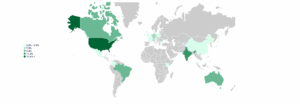
Voluntary Carbon Market Insights & FAQs
Everything you’ve ever wanted to know about the voluntary carbon market – and more!
Enhanced Rock Weathering (ERW)
What Is Enhanced Rock Weathering (ERW) and How Does It Work ?
- Enhanced Rock Weathering (ERW) is a carbon removal technique that involves spreading finely ground silicate minerals, such as basalt or olivine onto agricultural fields, forests, or coastal areas.
- These minerals naturally react with atmospheric CO2, forming stable carbonates and locking carbon away for thousands to millions of years.
Why Does Enhanced Rock Weathering (ERW) Matter for Global Climate Goals?
- ERW provides permanent carbon removal, storing CO2 in mineral form for geological timescales. It also delivers agricultural benefits by enhancing soil health and nutrient availability.
- Its global scalability, compatibility with agricultural practices, and alignment with natural geological processes make ERW a vital part of comprehensive Net Zero strategies.
What Is the Current Market Activity for Enhanced Rock Weathering (ERW) in Carbon Removal?
- The Enhanced Rock Weathering (ERW) market has seen steady growth, with almost 1 million credits sold to date. Investment in the sector has reached approximately $121 million, signalling increasing confidence in its scalability and role within the broader carbon removal landscape.
- Credit prices for ERW currently range from $200 to $500 per ton, reflecting variability in project scale, location, and methodology maturity
Total retirement by round

What Is the Current Project Activity for Enhanced Rock Weathering (ERW) and Global Capacity Trends?
- There are currently 54 developers active in the Enhanced Rock Weathering (ERW) market, with most based in the United States, Netherlands, Australia, Brazil, Germany, and India.
- The market is supported by several prominent suppliers, including TerraDot, CO2Lock, Lithos, Eion, and UNDO. These companies are advancing projects across multiple geographies, contributing to the sector’s growing recognition as a scalable and durable carbon removal solution.
Share by country – CDR developers

How Does AlliedOffsets Track Credit Activity for Enhanced Rock Weathering (ERW) in the Voluntary Carbon Market?
AlliedOffsets tracks ERW credit activity in the voluntary carbon market (VCM) through registry data and off-registry transactions. With data from 35+ registries, we provide the most comprehensive credit tracking available, covering:
- ERW issuances
- Retirements
- Offtake agreements
- Purchase vs. delivery trends over time
Total credits by transaction type

Who Is Purchasing Enhanced Rock Weathering (ERW) Credits and What Are the Market Trends?
- The Enhanced Rock Weathering (ERW) market is currently led by high-profile corporate and coalition buyers, with Frontier, Emitwise, and Google among the most active purchasers. These organizations are securing significant volumes of ERW credits, helping to establish early market confidence in the technology’s scalability and durability.
- Market activity is still in its early stages, but demand is steadily growing.
CDR purchases by buyer sector

What Are the Biggest Challenges in Scaling Enhanced Rock Weathering (ERW)?
The biggest challenges in scaling Enhanced Rock Weathering (ERW) relate to its energy, cost, and verification requirements.
- Energy intensive – Grinding and transporting minerals require significant renewable energy.
- Costly infrastructure – High capex for processing and distribution.
- Supply chain complexity – Requires sustainable, reliable mineral sourcing.
- Verification challenges – Difficulty in measuring precise carbon sequestration rates.
- Public acceptance – Concerns over mining impacts and large-scale land application.
What Are the Key Benefits of Enhanced Rock Weathering (ERW) for Carbon Removal and Agriculture?
The key benefits of Enhanced Rock Weathering (ERW) for carbon removal and agriculture include:
- Permanent carbon removal – Stores CO2 in stable mineral form for millennia.
- Soil improvement – Releases nutrients that enhance crop yield.
- Natural process – Mimics natural weathering and is globally scalable.
- Broad applicability – Usable in agricultural, forest, and coastal environments.
- Agricultural co-benefits – Reduces reliance on synthetic fertilizers.